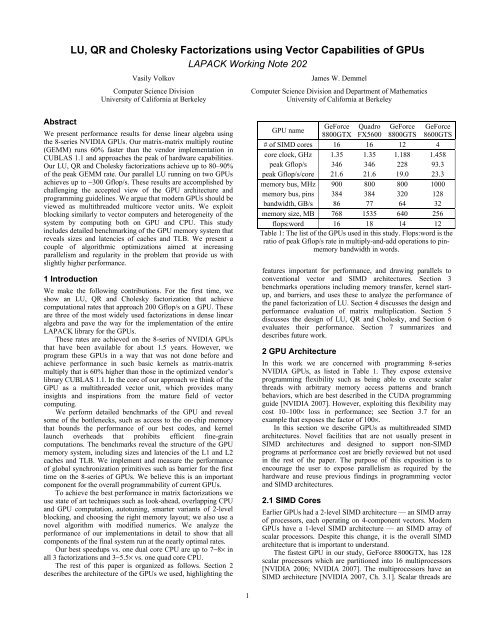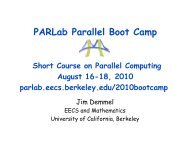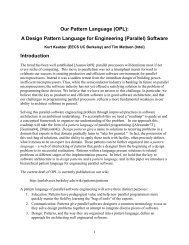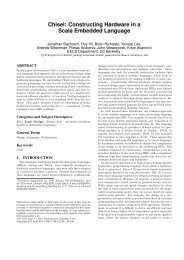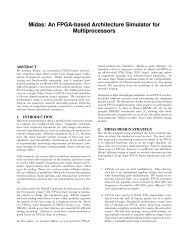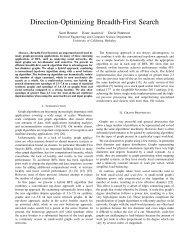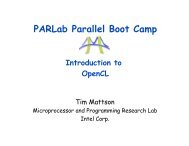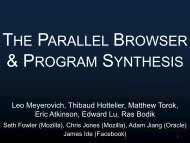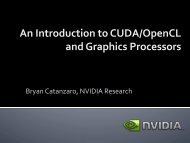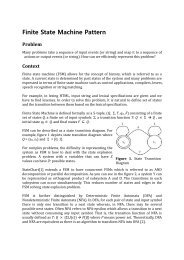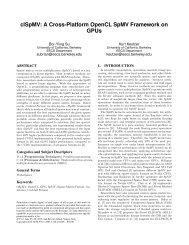LU, QR and Cholesky Factorizations using Vector ... - Par Lab
LU, QR and Cholesky Factorizations using Vector ... - Par Lab
LU, QR and Cholesky Factorizations using Vector ... - Par Lab
You also want an ePaper? Increase the reach of your titles
YUMPU automatically turns print PDFs into web optimized ePapers that Google loves.
Figure 1: Memory latency as revealed by the pointer chasingbenchmark on GeForce 8800 GTX for different kinds of memoryaccesses. Array size is shown in the boxes. Cached accessassumed unless otherwise specified. Blue, red <strong>and</strong> green lineshighlight 5KB cache, 192 KB cache, <strong>and</strong> 512KB memory pagesrespectively. Solid black is non-cached access, dashed black islocal memory.API (one cuLaunchGrid call or two cu<strong>Par</strong>amSetv <strong>and</strong>cuLaunchGrid calls if new arguments must be supplied —both cases give similar timings). It takes 5−7 µs if done with thehigher level API (> expression). This was measured byasynchronously invoking the same kernel a very large number oftimes <strong>and</strong> synchronizing once at the end (e.g. <strong>using</strong>cudaThreadSynchronize API call). The program usedwas the simplest possible, such as copying one word from onelocation in the GPU memory to another. This is to ensure thatthe program runtime does not contribute substantially to theoverall time. The time increases to 11−12 µs whensynchronizing at each kernel invocation. This gives an idea ofhow expensive the synchronization is.To ensure that we do not sacrifice performance by choosingCUDA for programming the GPU we also measured overheadsin DirectX 9.0c, which is a mature graphics API widely used incomputer games. The timings were 7 µs for invocation alone<strong>and</strong> 21 µs for invocation with synchronization (synchronizationis required when computing with DirectX to ensure correctness).This indicates that CUDA is as efficient as or better thanDirectX.3.2 CPU-GPU Data TransfersThe GPUs used in this study were designed for the PCIe 1.1 ×16interface that bounds the b<strong>and</strong>width of the CPU-GPU link by 4GB/s (newer GPUs support PCIe 2.0 which is twice as fast). Wefound that transferring contiguous pieces of data with sizes from1 byte to 100 MB long across this link <strong>using</strong> CUDA with pinnedmemory takes aboutbytes transferredTime =15µs + . (1)3.3GB /sThis fits the measured data within a few percent.3.3 GPU Memory SystemThe vendor’s manuals supply limited information on GPUcaches. The CUDA programming guide specifies an 8KB cacheworking set per SIMD core [NVIDIA 2007, Ch. A.1], i.e.128KB for the entire 8800 GTX chip (there is also a cache forsmall constant memory that we leave out of scope in this paper).He et al. [2007] estimate the size of the 8800GTX cache to be392KB. None of them differentiate levels of cache. However, itSIMD core #1 SIMD core #2Local memory16KB<strong>Vector</strong>registers32KBL1, 5KBL2 cache32KBDRAM1128MBLocal memory16KB<strong>Vector</strong>registers32KB...(16 cores)...(8 L1 caches)CROSSBAR…(6 L2 caches)…(6 banks)SIMD core #15 SIMD core #16Local memory16KB<strong>Vector</strong>registers32KBL1, 5KBL2 cache32KB64 64DRAM6128MBLocal memory16KB<strong>Vector</strong>registers32KBlatency(cycles)Figure 2: Summary of the memory system of 8800GTXaccording to our study. Sizes of the on-chip memory levels areshown in the same scale. Latencies shown are for the cachedaccess. Note the small size of the L1 caches.is known that the 8800GTX has one L1 cache per two cores <strong>and</strong>six L2 caches [NVIDIA 2006]. L1 caches are connected with L2caches via a crossbar.We use a traditional pointer chasing benchmark similar tothat used, for example, in LMBench 2 to reveal the latency <strong>and</strong>structure of the memory system. It traverses an integer array Aby running k = A[k] in a long unrolled loop, yielding the timeper one iteration. This time is dominated by the latency of thememory access. The traversal is done in one scalar thread, <strong>and</strong>so utilizes only one GPU core <strong>and</strong> may not see caches associatedwith other cores. The array is initialized with a stride, i.e. A[k] =k + stride mod array size. We test cached <strong>and</strong> non-cachedmemory access to the off-chip memory <strong>and</strong> also access to thelocal memory (in which case data is first copied from the offchipmemory <strong>and</strong> this time is later subtracted). Results fordifferent array sizes <strong>and</strong> strides on the 8800 GTX are shown inFig. 1.A larger latency indicates more cache misses. The array sizedefines the working set <strong>and</strong> reveals the cache size, such as 5KB<strong>and</strong> 192KB in the Figure. The higher latency of the long-stridenon-cached access indicates the presence of a TLB, which is notofficially documented to the best of our knowledge. The stridereveals cache lines <strong>and</strong> memory pages, such as 32 bytes <strong>and</strong>512KB in the Figure. When the stride is very large, working setdecreases until it again fits in the cache, this time producingconflict misses if cache is not fully associative. The data in Fig.1 suggests a fully associative 16-entry TLB (no TLB overheadfor 128MB array, 8MB stride), a 20-way set associative L1cache (20KB array at 1KB stride fits in L1), <strong>and</strong> a 24-way setassociativeL2 cache (back to L2 hit latency for 768KB array,32KB stride). These are the effective numbers <strong>and</strong> the realimplementation might be different. Six 4-way set-associative L2caches match this data as well.According to this data, L1 cache has 160 cache lines only (in8 fully associative sets). This promises a 100% miss rate inevery cached access unless scalar threads are sufficientlycoordinated to share cache lines.Figure 1 reveals a 470−720 cycle latency non-cachedmemory access that roughly matches the official 400−600 cyclefigure [NVIDIA 2007, Ch. 5.1.1.3].To find the total amount of the partitioned cache memory,we run a multithreaded test that utilizes all cores. We run onethread per core (this is enforced by holding a large amount oflocal memory per thread), each traversing through a private2 http://www.bitmover.com/lmbench26242803705103
array so that their working sets do not overlap. The results matchthe official data, with the effective size of L1 cache scaling withthe number of cores. Effective L2 cache size did not scale. Fig. 2summarizes the parameters of memory system of 8800GTXincluding the findings cited above. Preliminary study shows thatTLB also scales with number of cores.Similar tests <strong>and</strong> plots for other GPUs in this studysuggested the same sizes of L1 caches (5KB per 2 cores) <strong>and</strong>TLB (16 entries per TLB), <strong>and</strong> showed that L2 caches scale asmemory pins: 32KB for each 64 pins (to match 6 caches in the8800 GTX [NVIDIA 2006]). Also, it matches 128MB memoryper 64 memory pins on all GPUs but the FX5600, which hastwice as much memory. Our guess is that L2 GPU caches aresimilar in function to the hot-spot caches on the earlier highlymultithreaded processors such as Tera MTA [Alverson et al.1990] that were designed to alleviate contention at memorybanks.Latencies expressed in cycles were about same on all fourGPUs. Note that an L1 cache hit costs about 280 cycles (260 on8600 GTS) which is about half of the memory access latency.According to the vendor’s manual, the purpose of the GPUcache is to reduce “DRAM b<strong>and</strong>width dem<strong>and</strong>, but not fetchlatency” [NVIDIA 2007, Ch. 5.1.2.3]. Interestingly, the samepurpose is followed in the design of the vector cache in the CrayBlackWidow vector computer [Abts et al. 2007].Latency to the local memory is an order of magnitude lessthan to the cache ⎯ 36 cycles. To measure it more accurately<strong>and</strong> compare to the pipeline latency we performed a separateexperiments on 8800GTX. This time we execute a = a * b + coperation many times in an aggressively unrolled loop. We useddecuda to ensure that this operation maps to a single nativeinstruction. When all three variables are in registers themeasurements show 24 cycle throughput per instruction that is6× larger than at the peak throughput <strong>and</strong> is an estimate of thepipeline latency. Same test showed 26 cycles when b was inlocal memory. 2 extra cycles for operations with local memoryappear again in Section 3.5.24 cycle latency may be hidden by running simultaneously 6warps or 192 scalar threads per SIMD core, which explains thenumber cited in the CUDA guide [NVIDIA 2007, Ch. 5.1.2.5].3.4 Attaining Peak Instruction ThroughputWe were able to achieve 98% of the arithmetic peak on8800GTX in register-to-register multiply-<strong>and</strong>-add instructions.This was achieved running a single vector thread per SIMDcore. <strong>Vector</strong> length was two warps or 64 elements (1024 scalarthreads in total). Each thread performs a group of 6 independentmultiply-<strong>and</strong>-adds a million times in an aggressively unrolledloop. The number 6 was chosen to hide the pipeline latency nomatter how many threads are run per SIMD core. However, itdidn’t work when there was only one warp per SIMD core (wegot 50% of peak only) or two warps in different thread blocks(66% of peak) when <strong>using</strong> the same code.3.5 Throughput when <strong>using</strong> Local MemoryAccording to decuda, locations in local memory can be used asan instruction oper<strong>and</strong>. However, the best of our experimentsyielded only 66% of the arithmetic peak on all four GPUs inmultiply-<strong>and</strong>-add instructions with one oper<strong>and</strong> in localmemory. This corresponds to 6-cycle throughput per warpversus the usual 4 <strong>and</strong> 230 Gflop/s on 8800GTX.To isolate the effect, we tried different local memory accesspatterns keeping the structure of the inner loop unperturbed. Wefound that it takes 12 cycles per instruction if each local memoryaccess involves a 2-way local memory bank conflict (as definedin [NVIDIA 2007, Ch. 5.1.2.5]), 24 cycles if conflicts are 4-way, etc. This fits the description in the CUDA guide that saysthat conflicting accesses are serialized. This indicates that thebottleneck is in the local memory access, not in the hiddenpointer arithmetic.3.6 Faster Global BarrierA global barrier is a basic synchronization primitive that iswidely used in many parallel algorithms. Currently, it iscommon to assume that global barrier on the GPU should beimplemented by invoking a new kernel, which involvesexpensive overhead as we have found in Section 3.1. For thefirst time we show that it is possible to implement global abarrier within a single kernel run. Of course, it synchronizesonly among threads that run simultaneously <strong>and</strong> thus introducesexplicit dependence on the number of GPU cores. In Section 3.8we argue that this mechanism may be important in fine-graincomputations on the GPUs.Our implementation does not use atomic primitivesavailable in the newer GPUs (however, it assumes that wordwidenon-cached memory reads <strong>and</strong> writes are atomic). Instead,we replicate the variables used in the synchronization to ensurethat different threads never write to the same address. This keepschanges to these variables atomic. In our implementation weallocate arrival <strong>and</strong> wakeup variables for each vector thread.There is one master vector thread <strong>and</strong> others are slaves. The i-thslave updates the i-th arrival variable <strong>and</strong> spins on the i-thwakeup variable until that is updated. The master thread spins onthe arrival variables until every one is updated, then updatesevery wakeup variable. For better efficiency we lay out thecounters in memory to ensure that the head thread fetches <strong>and</strong>stores the variable values <strong>using</strong> a single SIMD memory access.In our prototype implementation we pick the vector length equalto the total number of vector threads created.1.3−1.6 µs or 1920−2000 cycles per barrier was observed onall four GPUs used in the study when running one vector threadper core. This is about 4 memory latencies of non-cached access,which is the minimum number of data trips between theprocessing chip <strong>and</strong> the memory as assumed by the algorithm.This time was up to 2800 cycles when running multiple (up to 8)vector threads per core.Although substantial, this time is 3−4× less than the kernellaunch overhead, so it can be used to speedup fine-graincomputations that otherwise require multiple kernel runs.However, we note that this barrier does not guarantee thatprevious accesses to all levels of the memory hierarchy havecompleted unless a memory consistency model is assumed.Also, its practical application is complicated by the inability tochange the thread block size <strong>and</strong> the register partitioning duringthe kernel execution.3.7 GPU Memory B<strong>and</strong>widthThe best b<strong>and</strong>width in copying within GPU memory on the8800GTX that we could attain was 76 GB/s, which is 88% ofthe pin-b<strong>and</strong>width. This proves that a large fraction of the peakb<strong>and</strong>width may be attained in SIMD accesses, which should bethe goal in all b<strong>and</strong>width-bound codes. However, the same codegets 11× lower b<strong>and</strong>width if the supplied pointers are notaligned. Thus, performance codes must always include basicoptimizations to avoid misaligned accesses. For example, amisaligned stride-1 copy should be converted into a largealigned stride-1 copy <strong>and</strong> one less efficient but much smallercopy at the head of the array. This can be performed within asingle kernel call.Even stronger deterioration is possible in strided accesses.4
Copying 2 18 32-bit numbers in GPU memory with strides 1, 8<strong>and</strong> 512 takes 34 µs, 260 µs <strong>and</strong> 2600 µs correspondingly,which is effectively 62 GB/s, 8.1 GB/s <strong>and</strong> 0.81 GB/s. This isdone by a simple code, where each vector thread reads <strong>and</strong>writes one vector with the given stride. Performing the sameoperation <strong>using</strong> the possibly better optimized vendor’s libraryCUBLAS 1.1 gave similar results.3.8 Implications for Panel FactorizationResults shown by Barrachina et al. [2008] <strong>and</strong> Baboulin et al.[2008] indicate that copying a matrix panel to the CPU memory,factorizing it <strong>using</strong> the CPU <strong>and</strong> transferring it back to the GPUmay take less time than performing panel factorization on theGPU <strong>using</strong> the vendor-supplied BLAS library. We analyze thisbehavior below <strong>using</strong> a performance model.Consider running the <strong>LU</strong> factorization of a panel as done inLAPACK’s sgetf2 on the GeForce 8800GTX. This routine isbuilt of calls to BLAS1 <strong>and</strong> BLAS2 that have flop-to-word ratioas low as 1 or 2, which is much below the flop-to-word ratio ofthe GPUs (see Table 1) <strong>and</strong> thus are b<strong>and</strong>width bound. Let usassume they are efficiently implemented, i.e. run inb<strong>and</strong>width requiredTime= 5µs + , (2)75GB/swhere we used the kernel launch overhead <strong>and</strong> the peaksustained b<strong>and</strong>width found above. (Although one might imaginean environment where runtime of the GPU program <strong>and</strong> launchoverhead overlap, we observed that these times sum up inpractice if the most efficient invocation routine in CUDA 1.1 isused.) For example, consider the BLAS1 routine sscal thatscales a vector by a constant factor. It does n flops <strong>and</strong> requires2n words of b<strong>and</strong>width for an n-element vector. The highest rateit can attain on this GPU is therefore r ∞ = 9.4 Gflop/s. Half ofthis rate is achieved at n 1/2 ! 47,000, i.e. it runs at 5−10µs forany n < 47,000. The best of our GPUs has 1.5GB memory thatfits up to 20,000×20,000 matrices. Thus, for practical squarematrix sizes sscal effectively runs in O(1) time instead of theasymptotic O(n).Using this model we estimate the runtime of the entirefactorization of an m×n panel, m > n. It involves n calls to eachof the isamax (finds largest element in a vector), sscal,sswap (swap rows) <strong>and</strong> n–1 call to sger (rank-1 update).Assume an ideal implementation, i.e. each routine reads <strong>and</strong>writes inputs <strong>and</strong> outputs only once (e.g. the input row <strong>and</strong>column in the rank-1 update stay in cache, registers or localmemory). Fig. 3 shows the result for n = 64 (labeled “estimate”)compared with few other Gflop/s rates. 64 is the panel width weuse in practice as described in Section 5.According to the plot, the GPU may yield up to 2.4×speedup vs. the CPU (labeled “CPU+transfer”) but may achievethis efficiency only at large problem sizes. The CPU timings inthe plot are h<strong>and</strong>icapped by including the time to transfer panelto the CPU <strong>and</strong> back computed as in (1).The asymptotic performance of the factorization computed<strong>using</strong> the model is 18.8 Gflop/s. Only a small fraction of it isachieved when factorizing a small panel mostly due to the largestartup times. To highlight the importance of the faster globalbarrier introduced in Section 3.6, we computed similar estimates<strong>using</strong> its overhead, which is 1.4µs on this GPU, as the startuptime in (2). The new estimate is plotted in the same Figure <strong>and</strong>labeled “fast barrier, estimate”. The new barrier promises toyield up to 3× speedup <strong>and</strong> outperforms CPU starting at smallerm ! 750.In the same graph we show two implementations of thepanel factorization on the GPU that are labeled “optimized” <strong>and</strong>“naive”. One of them is a naïve implementation that executesFigure 3: Gflop/s rates achieved in <strong>LU</strong> factorization of m×64panel. GPU is 8800GTX programmed <strong>using</strong> CUDA 2.0 beta,CPU is 2.66GHz Core2 Duo CPU <strong>using</strong> Intel MKL 10.0. Curvecorresponds to the GPU performance if not specified otherwise.Dashed lines are theoretical estimates, others are empirical data.LAPACK’s sgetf2 code <strong>using</strong> CUBLAS 2.0 beta. This is anewer version of CUBLAS that contains a faster implementationof sger than in CUBLAS 1.1. The only substantial differencewith the LAPACK code that we introduced was not checking if1/a ii underflows, thus always <strong>using</strong> cublasSscal. The factorsa ii were fetched to the CPU <strong>using</strong> cublasGet<strong>Vector</strong>. Thisversion achieves up to 1.5 Gflop/s which is only 11% of theestimated value. This is also 10% of the peak sustained rate ofcublasSger which is 15.0 Gflop/s for aligned data. The lowfraction is due to working with unaligned data.The second implementation included a couple of basicoptimizations. The most important optimization was toimplement sger as two calls to cublasSger in the mannerdescribed in Section 3.7 to reduce the work done with unaligneddata. Another optimization was implementing isamax on theCPU if m is small enough. In that case the data is first fetched tothe CPU memory, then reduction is performed. Thisimplementation runs up to 5× faster than cublasIsamax inCUBLAS 2.0 beta, which never takes less than 74µs (~15 kernellaunch overheads!). Finally, scaling was implemented by acustom kernel that does not require copying a ii to the CPU. Theoptimized version runs at up to 5.8 Gflop/s which is nearly 4×speedup compared to the non-optimized code. However, this isonly 41% of the estimated value.The rate achieved in cublasSger in the optimized code isshown in the same plot (labeled “sger alone”). Most of the workis done in this routine. Note the gap in performance with theentire panel factorization. This is the practical slowdown due tothe low work-to-cost ratio of isamax, sscal <strong>and</strong> sswap.Further optimization might bring performance closer to theestimates. However, there could be other fundamentalbottlenecks that prohibit achieving this simplified estimate.Implementing panel factorization on the GPU may not worth theeffort <strong>and</strong> it may be preferable to offload this work to the CPU.We always perform panel factorization on the CPU in practice.4 Design of Matrix-Matrix Multiply RoutineIn this Section we describe the designs of AB <strong>and</strong> AB T matrixmatrixmultiplication routines that run at up to 90% of thearithmetic peak for operations <strong>using</strong> local memory as found inSection 3.5. This is 60% faster than in the CUBLAS 1.1 libraryreleased by NVIDIA. At the time of writing, our codes havebeen adopted NVIDIA <strong>and</strong> are included in CUBLAS 2.0 beta. In5
efore the first local barrier as in Fig. 4 with appropriatememory accesses. In the case of the AB version, this means thatall fetches of A are placed after the first local barrier to avoidextra overlap in latencies. According to the table, these codesrun 7−11% slower indicating the effectiveness of <strong>using</strong>prefetching in hiding the latency.On all four GPUs the code performed at 89–90% of the peakperformance with participation of local memory, or 59–60% ofthe peak arithmetic performance. This means it scales well withthe number of cores <strong>and</strong> clock rate, corresponds to 11−14Gflop/s per core. Substantially faster code could be built only if<strong>using</strong> local memory less intensively.Future GPUs might have faster access to local memory. Ifaccessing local memory in multiply-<strong>and</strong>-add did not involveextra cost <strong>and</strong> latency was still well-hidden, a similarperformance estimate promises ~80% of arithmetic peak boundby ~20% of instructions spent in pointer arithmetic, fetchinstructions, synchronization <strong>and</strong> flow control. For comparison,sgemm in Intel MKL 10.0 run on a 2.4GHz Core2 Quad runs at70 Gflop/s, which is 91% of the arithmetic peak.64×16 blocking yields 25.6× reduction of b<strong>and</strong>widthconsumption. Thus, 206 Gflop/s achieved on 8800 GTXcorresponds to 32 GB/s in reading matrices A <strong>and</strong> B, which is43% of the peak sustained b<strong>and</strong>width. In contrast, some of theearlier methods, such as Govindaraju et al. [2006] <strong>and</strong>Fatahalian et al. [2004] are b<strong>and</strong>width-bound.Fig. 5 plots runtime of the algorithm versus the number ofblocks in C, i.e. the number of vector threads. Step-pattern isdue to the round-robin distribution of vector threads across theGPU cores. This produces poor load balance when number ofthreads is small. The runtime of the two-stage version optimizedfor small matrices grows nearly linearly with the amount of thework done as it creates many more threads than the number ofblocks in C. Fig. 6 summarizes the performance of our algorithmfor square <strong>and</strong> skinny matrices compared to CUBLAS 1.1 <strong>and</strong>matrix multiply as implemented in Intel MKL 10.0 <strong>and</strong> run on2.4GHz Core2 Quad Q6600 running 64-bit Linux.The version of the code that deals with a square blocktriangular matrix C <strong>and</strong> full matrices A <strong>and</strong> B runs at the samepeak rates as for a full matrix C. However, a simpler solutionbased on more threads some of which exit early runs at 10%lower peak <strong>and</strong> was ~30% slower for some matrix sizes. Thus,creating large number of empty threads may have a substantialimpact on the overall performance.5 Implementation of One-Sided Matrix<strong>Factorizations</strong>We consider the factorization of matrices that reside in the CPUmemory in column-major layout, <strong>and</strong> whose factorizationsoverwrite the original data. The intention is to match thesemantics of LAPACK routines [Anderson et al. 1990].However, for the purpose of this study we restrict our attentionto square matrices whose dimension is a multiple of the blocksize used.There are three classical bulk-synchronous variants of <strong>LU</strong>factorization — left-looking, right-looking <strong>and</strong> Crout [Dongarraet al. 1998]. We dismiss the left-looking scheme as it does abouthalf its flops in triangular solves with small number of righth<strong>and</strong>sides <strong>and</strong> so has limited inherent parallelism. We prefer theright-looking algorithm to the Crout algorithm because itexposes more thread-level parallelism in the calls to matrixmatrixmultiply. <strong>Cholesky</strong> <strong>and</strong> <strong>QR</strong> factorizations work in thesame manner — the entire matrix is updated as soon as nextblock column is available.Panel factorization is done on the CPU as doneindependently by Barrachina et al. [2008] <strong>and</strong> Baboulin et al.[2008]. However, in our implementation triangular solve in<strong>Cholesky</strong> is also done on the CPU (we are most interested inbetter performance at large problem sizes). The panelfactorization is overlapped with computation on the GPU <strong>using</strong>a look-ahead technique (see e.g. Dongarra <strong>and</strong> Ostrouchov[1990] who call it pipelined updating). This requires transferringmatrix panels from the GPU to CPU memory <strong>and</strong> back. Thetransfers are currently not overlapped with the computation onthe GPU, as our best GPUs (8800GTX <strong>and</strong> FX560) do notpermit it (unlike the newer GPUs).To avoid extra overhead in the transfers, the panels areplaced into their final output location when transferred to theCPU memory. Thus panel factorization produces the finalresults for those locations, except for <strong>LU</strong> factorization, whichrequires pivoting of the entire matrix at each panel factorization,which is done on the GPU. The transfer of the triangular matrixin the <strong>Cholesky</strong> factorization is done by transferring a set ofrectangular blocks that includes the triangular part. The width ofthe blocks is optimized <strong>using</strong> the performance model presentedin Section 3.2.To avoid the severely penalized strided memory access inpivoting on the GPU, the matrix is laid out in the GPU memoryin row-major order. This involves extra overhead for thetransposition <strong>and</strong> applies to <strong>LU</strong> factorization only. Thetransposition of the square matrix is done in-place to avoid extraspace requirements (a slightly more complicated solution maybe used with non-square matrices). When the panel is transferredto the CPU memory <strong>and</strong> back, it is transposed on the GPU <strong>using</strong>an additional, smaller, buffer. Pivoting kernel does 64 rowinterchanges per call to amortize the kernel launch overhead.The pivot indices are passed in as function parameters that areaccessible via local memory in CUDA. This avoids any memoryaccess overhead in reading them.Only the lower triangular part of the output of the panelfactorization in the <strong>QR</strong> algorithm is needed for the update doneon the GPU. It is filled in with zeros <strong>and</strong> a unit diagonal tocreate a rectangular matrix, so that it can be multiplied <strong>using</strong> asingle matrix-matrix multiply. A similar technique is used inScaLAPACK [Choi et al. 1996]. The same technique is usedwith the small triangular matrix that arises in the panelfactorization in <strong>QR</strong>. These fill-ins are done on the CPU tooverlap with the work on the GPU.Instead of running triangular solve in the <strong>LU</strong> decompositionwe run matrix-matrix multiply with the inverse of the triangularmatrix. The inverse is computed on the CPU. Unlike otheroptimizations, this may affect the numerical stability of thealgorithm. However, our numerical tests so far show nodifficulty <strong>and</strong> in fact the stability of either algorithm depends onthe essentially the same assumption, namely that L −1 is not toolarge in norm, since this bounds both pivot growth <strong>and</strong> theaccuracy of the triangular solve. In the future we might revert totriangular solve when ||L −1 || is too large.The block size used is the same as in the matrix multiply(64). A larger block size could reduce b<strong>and</strong>width consumption<strong>and</strong> improve performance with large matrices. We address theb<strong>and</strong>width consumption <strong>using</strong> two techniques.The first technique is a variant of 2-level blocking (this wasindependently done in [Barrachina et al. 2008]). Both levels aredone in the right-looking manner to use a large number ofthreads in the matrix multiply. A novel tweak is that we switchto the coarse blocking level when only half the finer level iscomplete. This avoids updating matrices that have too few blockcolumns <strong>and</strong> so offer little thread parallelism in the matrixmultiplies. Note, that this approach is not a subset of thetraditional recursive blocking.A different technique is used in <strong>QR</strong> factorization, which has8
approach peak rates of the matrix-matrix multiply presented inSection 4.4. Performance of BLAS3 bounds performance ofentire factorization as it’s the fastest component of thealgorithm. The gap between BLAS3 <strong>and</strong> factorization ratesillustrates the impact of the other work done. The gap is thelargest in the case of <strong>LU</strong> decomposition, which requirespivoting, transposition <strong>and</strong> transferring the final result back tothe CPU unlike the two other factorizations.The same plot also includes the rates achieved in thefactorizations done <strong>using</strong> Core2 Quad alone, <strong>and</strong> Figure 8 detailsthe speedups vs. Core2 Duo <strong>and</strong> Core2 Quad. According to theFigure, the crossover between the GPU-based <strong>and</strong> CPU-aloneimplementations is at n = 200−400 for <strong>LU</strong> <strong>and</strong> <strong>QR</strong> algorithms.<strong>Cholesky</strong> always runs faster than the CPU-alone implementationon the Core2 Duo (which might indicate inefficiency of the CPUimplementation). Crossover with the performance of the CPUalonealgorithm running on Core2 Quad is at n = 500−700. Thebest performances are summarized in Table 3. It shows that thespeedup is nearly the same as the speedup in the matrix-matrixmultiply (sgemm) <strong>and</strong> even better when comparing to the Core2Quad.Finally, Fig. 9 shows the performance of the <strong>LU</strong>decomposition that achieves ! 300 Gflop/s at n ! 18,000 byrunning two GPUs in parallel.6.2 Performance AnalysisThe different rates in the BLAS3 routines in Fig. 8 are due todifferent amounts of the thread level parallelism (TLP) exposedin the bulk matrix multiplies. Right-looking <strong>LU</strong> decompositionexposes the most TLP, <strong>and</strong> right-looking <strong>Cholesky</strong> exposes less,as it runs similar updates but for triangular matrices that haveabout half as many blocks (this may explain why the <strong>Cholesky</strong>curve looks similar to the <strong>LU</strong> curve shifted right by factor oftwo). Around half of the BLA3 operations in <strong>QR</strong> factorizationare involved in producing a skinny matrix, thus running slowerthan in BLAS3 in <strong>LU</strong> factorization. BLAS3 in <strong>QR</strong> speeds up forlarger n as adaptive blocking switches to less skinny matrices.However, <strong>QR</strong> factorization achieves the overall highest speedamong the three factorization as it does more flops in matrixmultiplies than any other algorithm.Fig. 10 shows the breakdown of runtime in the <strong>LU</strong>factorization. The breakdown for <strong>Cholesky</strong> looks similar, butdoes not have the transpose time, the CPU-GPU transfer takesless time (no transferring the entire matrix back) <strong>and</strong> overlapbetween CPU <strong>and</strong> GPU is not as good due to less work done inmatrix-matrix multiply (the panel factorization has about samecost). We did not do this analysis for <strong>QR</strong> but expect the workdone on the CPU to be hidden better than in <strong>LU</strong>. The breakdownshows that up to 90% of the runtime is consumed by computingon the GPU <strong>and</strong> about of 10% of this time overlaps withcomputing on the CPU. It reveals a potential use ofasynchronous transfers that could save another 10% of time, ifavailable in hardware. Another speedup is possible withoffloading more work to the CPU as currently up to 80% of timeGPU works alone. Time spent in transposing the matrices is notsubstantial. Individual measurements have shown that transposeruns at 25−45 GB/s for n > 1000. This variation in b<strong>and</strong>width isdue to the moderate granularity of this operation. For example, ittakes ~7.5µs to copy or transpose a 1024×64 matrix at 70 GB/s,which is about the same as the kernel launch overhead. CPU-GPU transfers run at 3.0−3.3GB/s for n > 1000, whichapproaches the peak sustained b<strong>and</strong>width as in Section 3.2.Fig. 11 evaluates the impacts of different optimizationsused. The most important optimization was <strong>using</strong> row-majorlayout on the GPU. If not used, we lose about half of the Gflop/srate. We measured pivoting individually <strong>and</strong> found that it takesFigure 10: The breakdown of time in the <strong>LU</strong> decomposition.Figure 11: Slowdown when omitting one of the optimizationsused.1−10% of time in the entire computation for n > 1000 if done inthe row-major layout. In that case it achieves 7−17 GB/s ofeffective b<strong>and</strong>width. When <strong>using</strong> column-major layout, it cantake up to 56% of total time <strong>and</strong> run at 0.2−2GB/s, with slowerrates for larger matrices.A surprisingly large speedup (up to 30%) was obtained byperforming triangular solve via multiplying by the inversematrix. Triangular solve with a 64×64 triangular matrix <strong>and</strong>4096 right h<strong>and</strong> sides runs at 13 Gflop/s when <strong>using</strong> CUBLAS1.1 or CUBLAS 2.0 beta. It is an order of magnitude slower thanthe 160 Gflop/s rate achieved in multiplying a 64×64 matrix bya 64×4096 matrix that does the same work (this is 80 Gflop/s ifnot counting the redundant work).The best speedups by <strong>using</strong> autotuning to choose block sizesin <strong>QR</strong> <strong>and</strong> in 2-level schemes in <strong>LU</strong> <strong>and</strong> <strong>Cholesky</strong> were 7%, 6%<strong>and</strong> 4% correspondingly <strong>and</strong> factored in only for n > 4096.According to Fig. 9, <strong>using</strong> two GPUs yields only ~67%improvement in the Gflop/s rate. Benchmarks of CPU-GPUtransfers showed only 1.6 GB/s peak in the transfers with thesecond GPU. Apparently it is working at PCI-e ×8 rate, we donot know if this can be remedied. As we perform factorization ina bulk-synchronous manner, the runtime is bound by the slowesttransfer. There are other sources of slowdown, such as extraCPU-GPU b<strong>and</strong>width consumption, lack of 2-level blocking <strong>and</strong>keeping the number of CPUs constant.6.3 Comparison with Other WorkThe first implementation of the <strong>LU</strong> factorization <strong>using</strong> GPUsthat we know was published by Galoppo et al. [2005] <strong>and</strong> ran at10
up to ~10 Gflop/s for n = 4000 without pivoting <strong>and</strong> at ~6Gflop/s for n = 3500 with partial pivoting on the older GeForce7800. This is 13× <strong>and</strong> 22× slower than our implementation donewith partial pivoting at these matrix dimensions. As discussedabove, in our implementation pivoting does not introduce asmuch slowdown.Barrachina et al. [2008] report 50 Gflop/s in <strong>LU</strong>factorization <strong>and</strong> 41 Gflop/s in <strong>Cholesky</strong> factorization for n =5000 <strong>using</strong> CUBLAS 1.0 on GeForce 8800 Ultra. This GPU isfaster than the 8800 GTX that we use (6.4% higher processorclock rate <strong>and</strong> 11% higher pin-b<strong>and</strong>width). Our implementationachieves 2.9× <strong>and</strong> 3.7× higher speed for <strong>LU</strong> <strong>and</strong> <strong>Cholesky</strong> resp.This is due to our improved matrix-matrix multiply routine <strong>and</strong>the optimizations evaluated above.Baboulin et al. [2008] describes implementation of <strong>LU</strong> <strong>and</strong><strong>QR</strong> algorithms that run at up to ≈55 Gflop/s on Quadro FX5600for n ≈ 19,000 <strong>using</strong> CUBLAS 1.0. This GPU is similar to whatwe use (see Tables 1 <strong>and</strong> 2). Their implementation of <strong>Cholesky</strong>runs at up to 90 Gflop/s if <strong>using</strong> CUBLAS <strong>and</strong> approaches 160Gflop/s if <strong>using</strong> an early version of the matrix multiplydescribed in this paper <strong>and</strong> offloading BLAS1/BLAS2operations to the CPU. Our implementation achieves higherrates at smaller orders of matrix, thus is more efficient.Castillo et al. [2008] report results for <strong>Cholesky</strong>factorization run on 4-GPU NVIDIA Tesla S870. Each of theseGPUs is roughly equivalent to Quadro FX5600. Authors report180 Gflop/s on a system at n ≈ 10,000. We achieve thisperformance <strong>using</strong> one GPU only. Their result was laterimproved to 424 Gflop/s at n ≈ 20,000 by <strong>using</strong> matrix multiplyroutine presented in this paper [Quintana-Orti et al. 2008].7 ConclusionsWe have presented the fastest (so far) implementations of dense<strong>LU</strong>, <strong>QR</strong> <strong>and</strong> <strong>Cholesky</strong> factorizations running on a single ordouble NVIDIA GPUs. Based on our performancebenchmarking <strong>and</strong> modeling, they attain 80%−90% of the peakspeeds possible for large matrices. This speed was achieved bycarefully choosing optimizations to match the capabilities of thehardware, including <strong>using</strong> the CPU in parallel with the GPU toperform panel factorizations, which are dominated by BLAS1<strong>and</strong> BLAS2 operations done faster on the CPU. We alsochanged the <strong>LU</strong> algorithm to use explicit inverses of diagonalsubblocks of the L factor, <strong>and</strong> showed this was both faster than<strong>and</strong> as numerically stable as the conventional algorithm.We also presented detailed benchmarks of the GPU memorysystem, kernel start-up costs, <strong>and</strong> barrier costs, which areimportant to underst<strong>and</strong>ing the limits of performance of manyalgorithms including our own. We also identified a new way todo global barriers faster, but which may or may not providememory consistency.Future work includes designing two-sided factorizations,such as in dense eigenvalue problems, one-sided factorizationson a GPU cluster <strong>and</strong> exploring the new performanceopportunities offered by newer generations of GPUs.ReferencesABTS, D., BATAINEH, A., SCOTT, S., FAANES, G.,SCHWARZMEIER, J., <strong>LU</strong>NDBERG, E., JOHNSON, T., BYE, M.,AND SCHWOERER, G. 2007. The Cray BlackWidow: A HighlyScalable <strong>Vector</strong> Multiprocessor, SC’07.AGARWAL R. C., AND GUSTAVSON, F.G. 1989. <strong>Vector</strong> <strong>and</strong>parallel algorithms for <strong>Cholesky</strong> factorization on IBM 3090,Supercomputing’89, 225–233.ELVERSON, R., CALLAHAN, D., CUMMINGS, D., KOBLENZ, B.,PORTERFIELD, A., AND SMITH, B. 1990. The Tera ComputerSystem, ICS’90, 1–6.AMD. 2006. ATI CTM Guide, version 1.01.ANDERSON, E., BAI, Z., DONGARRA, J., GREENBAUM, A.,MCKENNEY, A., DU CROZ, J., HAMMERLING, S., DEMMEL, J.,BISCHOF, C., AND SORENSEN, D. 1990. LAPACK: a portablelinear algebra library for high-performance computers,Supercomputing’90, 2–11.ANDERSON, E., BRANDT, M., AND YANG, C. 2004. LINPACKBenchmark Optimizations on a Virtual Processor Grid, InCray User Group 2004 Proceedings.BABOULIN, M., DONGARRA J., AND TOMOV, S. 2008. SomeIssues in Dense Linear Algebra for Multicore <strong>and</strong> SpecialPurpose Architectures, Technical Report UT-CS-08-200,University of Tennessee, May 6, 2008 (also LAPACKWorking Note 200).BARRACHINA, S., CASTILLO, M., IGUAL, F. D., MAYO, R, ANDQUINTANA-ORTI, E. S. 2008. Solving Dense Linear Systemson Graphics Processors, Technical Report ICC 02-02-2008,Universidad Jaime I, February 2008.BISCHOF, C. H., AND LACROUTE, P. G. 1990. An adaptiveblocking strategy for matrix factorization, in Proceedings ofthe joint international conference on <strong>Vector</strong> <strong>and</strong> parallelprocessing, 210–221.CASTILLO, M., CHAN, E., IGUAL, F. D., MAYO, R., QUINTANA-ORTI, E. S., QUINTANA-ORTI, G., VAN DE GEIJN, R., AND VANZEE, F. G. 2008. Making Programming Synonymous withProgramming for Linear Algebra Libraries, FLAME WorkingNote #31. The University of Texas at Austin, Department ofComputer Sciences. Technical Report TR-08-20. April 17,2008.CHOI, J., DONGARRA, J. J., OSTROUCHOV, L. S., PETITET, A. P.,WALKER, D. W., AND WHALEY, R. C. 1996. The Design <strong>and</strong>Implementation of the ScaLAPACK <strong>LU</strong>, <strong>QR</strong>, <strong>and</strong> <strong>Cholesky</strong>Factorization Routines, Scientific Programming 5, 3, 173–184(also LAPACK Working Note 80).DONGARRA, J., DUFF, I. S., SORENSEN, D. C., AND VAN DERVORST, H. A. 1998. Numerical Linear Algebra for High-Performance Computers, SIAM.DONGARRA, J., AND OSTROUCHOV, S. 1990. LAPACK BlockFactorization Algorithms on the Intel iPSC/860, TechnicalReport CS-90-115, University of Tennessee (also LAPACKWorking Note 24).GALOPPO, N., GOVINDARAJU, N. K., HENSON, M., ANDMANOCHA, D. 2005. <strong>LU</strong>-GPU: Efficient Algorithms forSolving Dense Linear Systems on Graphics Hardware, SC’05.GOVINDARAJU, N. K., LARSEN, S., GRAY, J., AND MANOCHA, D.2006. A Memory Model for Scientific Algorithms on GraphcsProcessors, SC’06.FATAHALIAN, K., SUGERMAN, J., AND HANRAHAN, P. 2004.Underst<strong>and</strong>ing the efficiency of GPU algorithms for matrixmatrixmultiplication, In Graphics Hardware 2004, 133–137.HE, B., GOVINDARAJU, N. K., <strong>LU</strong>O, Q., AND SMITH, B. 2007.Efficient Gather <strong>and</strong> Scatter Operations on GraphicsProcessors, SC’07.NVIDIA. 2006. NVIDIA GeForce 8800 GPU ArchitectureOverview, Technical Brief, November 2006.NVIDIA. 2007. NVIDIA CUDA Compute Unified DeviceArchitecture, Programming Guide, v. 1.1.QUINTANA-ORTI, G., IGUAL, F. D., QUINTANA-ORTI, E. S., ANDVAN DE GEIJN, R. 2008. Solving Dense Linear Systems onPlatforms with Multiple Hardware Accelerators, FLAMEWorking Note #32. The University of Texas at Austin,Department of Computer Sciences. Technical Report TR-08-22. May 9, 2008.11


